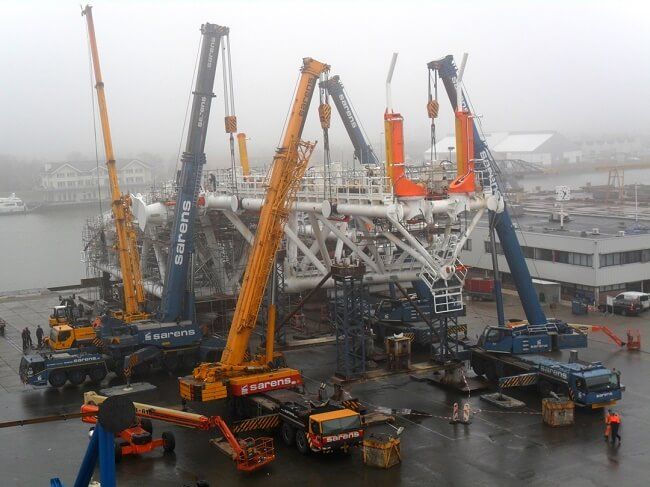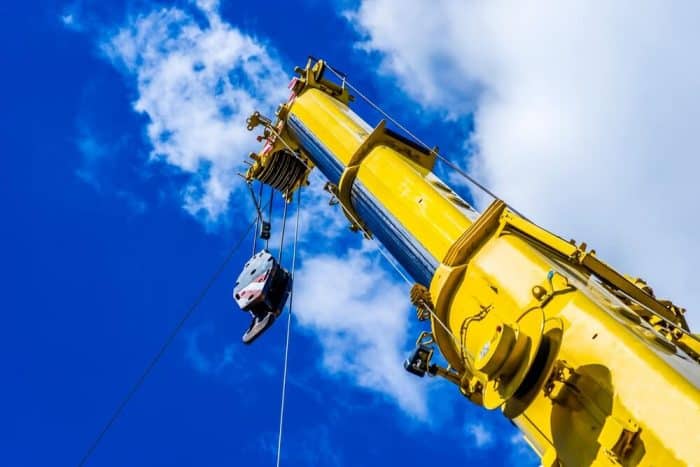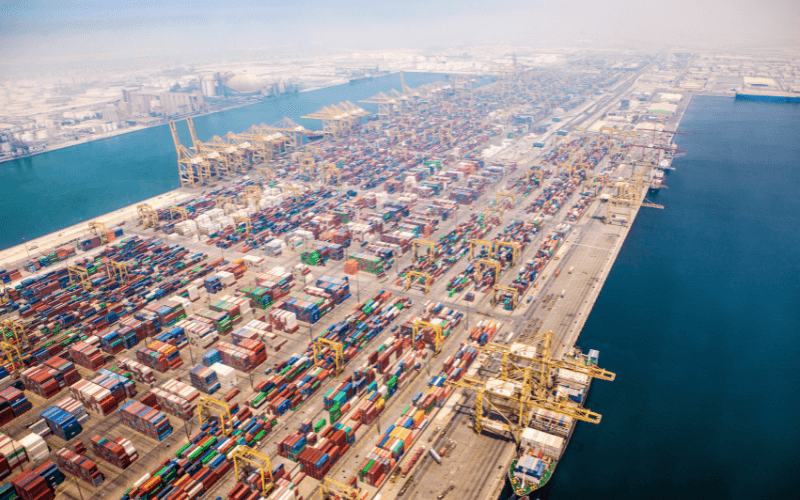World’s First Global Maritime Competition
What Are Telescopic Cranes?
Marine cranes are special equipment that facilitates the lifting of heavy loads and makes the movement of tons of materials from one place to another easier. Telescopic cranes are a form of heavy crane employed to transport objects.
Cranes like telescopic cranes are often used in day-to-day hauling operations. These heavy cranes are essential for manoeuvring operations in shipping ports.
Telescopic cranes can flexibly transport goods and items as they are mobile in their movement. They are further equipped with height adjustments, and thus, problems related to height are completely eradicated when hauling and transferring goods from one place to another.
Telescopic cranes offer one of the best services possible in shipping ports. Cargo embarking and disembarking takes place in any port without a second’s pause.
Given the disadvantages of several other heavy cranes, telescopic cranes offer premium support for the smooth functioning of port duties.
Related Read: Measures Taken During Shipboard Operation for the Safety of Ship’s Crew, Cargo, and Marine Environment

Telescopic cranes also play a significant role in all sorts of marine jobs, whether it is ship-to-shore work or the erection of oil platforms offshore.
Some of the common applications of marine cranes are listed below:
- Cranes help in both sinking and raising the equipment from the deep seas or some other waterways i.e. cranes allow transportation of equipment or material on or from the seabed.
- Cranes are used to move equipment or freight around the deck.
- Cranes help in loading the equipment and materials to and from other platforms as well as other vessels.
History of Telescopic Cranes
The Construction Industry was the first known field to use cranes, and the Ancient Greeks were the first to develop them. These ancient cranes were either driven by men or animals such as donkeys, oxen, etc.
The first crane built was a shorter-reach jib crane. These were used for taller construction, where manual transportation of material slowed down the construction process, and thus, engineering cranes were developed to fasten the construction.
In the 15th century, with the beginning of trade over oceans, the maritime industry was also influenced by these construction cranes. The industry required cranes for loading and unloading heavy freights and started developing marine cranes on the outline of construction cranes.
The 15th century witnessed the first harbour crane for loading and unloading ships. These cranes were initially made of wood, but with the Industrial Revolution, iron, steel, and cast iron replaced wood cranes completely.
Related Read: The History of Shipbuilding in India
In the 18th and 19th centuries, steam and electric cranes were developed, which were much more efficient than manual cranes and provided impressive services at ports. In the late 20th century, cranes with boomsticks became operational, which we today refer to as telescopic cranes or telescopic boom cranes.
These are hydraulic cranes, and they can be mounted on any heavy vehicle and operated from its top. They can be driven to places where goods and cargo need to be shifted. Further technical advancement improved the working of telescopic cranes by imparting more flexibility in services, higher lifting capacities, and height controls.
Types of Telescopic Cranes
Telescopic cranes can be classified into different categories as follows:
- Two types of Telescopic cranes are standardized by the Maritime Industry based on their carriage capacity, namely, smaller models with slewing cylinders (HM type) and larger models with slewing rings (HMR type).
- As per their construction mode, Telescopic cranes are also categorised into single-unit telescopic cranes and double-unit telescopic cranes. Telescopic cranes may sometimes be constructed as a single unit which can be easily moved from one place to another or two-unit equipment. A double unit telescopic crane consists of two parts viz. a telescopic mast and a superstructure called jib. The superstructure can be mounted over a truck, and it can function similarly to a telescopic crane.
- According to the classification of Telescopic cranes based on the number of engines powering them, they are of two types: single-engine machines and separate-engine machines. The former has only one engine, which powers both the undercarriages and the superstructure of the crane, whereas the former is more efficient and has a larger carrying capacity due to separate engines powering the undercarriage and the superstructure.
Related Read: Container Gantry Crane : Construction and Operation
In any port, many such telescopic cranes are present, enabling the easy mobility and transfer of cargo to the right containers, thereby providing utility in the best way possible.
The main difference between a telescopic crane and other conventional cranes is that the former has a hollow boom containing several tubes fitted one side to the other. A hydraulic mechanism enables the beam’s elongating and refracting motion.
Telescopic Cranes: Constructional Features and Applications
The key feature that differentiates a telescopic crane from other conventional cranes is that it has a hollow boom that consists of several tubes fitted one adjacent to the other. These tubes increase the crane’s gross hauling height, and objects are raised and dropped with the help of these tubes, which work through the hydraulic mechanism.

Telescopic cranes also offer the best service in transporting goods. They have the highest reach and can adjust their height according to the requirements. No other heavy crane can lift any object to such a height as these cranes do. These cranes can also be utilised in rescue operations, i.e., in salvaging sunken ships. They also find their application in building oil rigs.
Related Read: Types of Marine Salvage
Considering today’s fast-paced development, it is natural that cranes have started to be used extensively. However, in terms of the shipping industry and transportation of goods and cargo via the medium of ships, cranes have always been the primary technology used. This is because when it comes to hauling goods and transferring cargo from one area in a port to another, it is very difficult to use simple luggage racks, for the quantity and weight of the cargo at ports is quite heavy and thus requires help of such telescopic cranes to carry out the procedure of cargo transfer.
Heavy cranes are thus highly important equipment for the shipping industry. And of all the variants of heavy cranes, telescopic cranes are unique because they not only offer utility but also mobility side-by-side.
Related Read: 5 Massive Crane Ships Operating at the Sea
Disclaimer :
The information on this website is for general purposes only. While efforts are made to ensure accuracy, we make no warranties of any kind regarding completeness, reliability, or suitability. Any reliance you place on such information is at your own risk. We are not liable for any loss or damage arising from the use of this website.
Disclaimer :
The information on this website is for general purposes only. While efforts are made to ensure accuracy, we make no warranties of any kind regarding completeness, reliability, or suitability. Any reliance you place on such information is at your own risk. We are not liable for any loss or damage arising from the use of this website.
Related Articles
⚓️ Enhance Your Knowledge. Prevent Accidents. Stay Safe at Sea.
1. eBooks for Engine Department
Master machinery operations, troubleshooting, and safety procedures with expertly written guides tailored for marine engineers. Prevent costly breakdowns and onboard accidents through practical knowledge.
👉 Explore Engine Department eBooks
2. eBooks for Deck Department
Sharpen your seamanship, navigation, and cargo-handling skills with real-world case studies and practical insights designed for deck officers and cadets.
👉Discover Deck Department eBooks
3. eBooks on Electrical Fundamentals & Issues
Understand marine electrical systems, identify potential faults, and prevent onboard electrical failures with step-by-step explanations from industry experts.
4. Pocket Guides for Quick Reference
Compact, handy, and loaded with essential checklists—perfect for on-the-go reference during operations and emergencies at sea.
5. Combo Packs to Save Big
Access multiple expert eBooks at discounted prices. Ideal for professionals seeking complete safety and operational knowledge across various ship departments.
6. Digital Maritime Courses – Learn at Your Own Pace
Upgrade your competence with Marine Insight Academy’s online courses. Learn from industry professionals anytime, anywhere, and become a safer, smarter seafarer.
Subscribe To Our Daily Newsletter
By subscribing, you agree to our Privacy Policy and may receive occasional deal communications; you can unsubscribe anytime.






I love What are Telescopic Cranes? | Marine Insight, it’s so great!